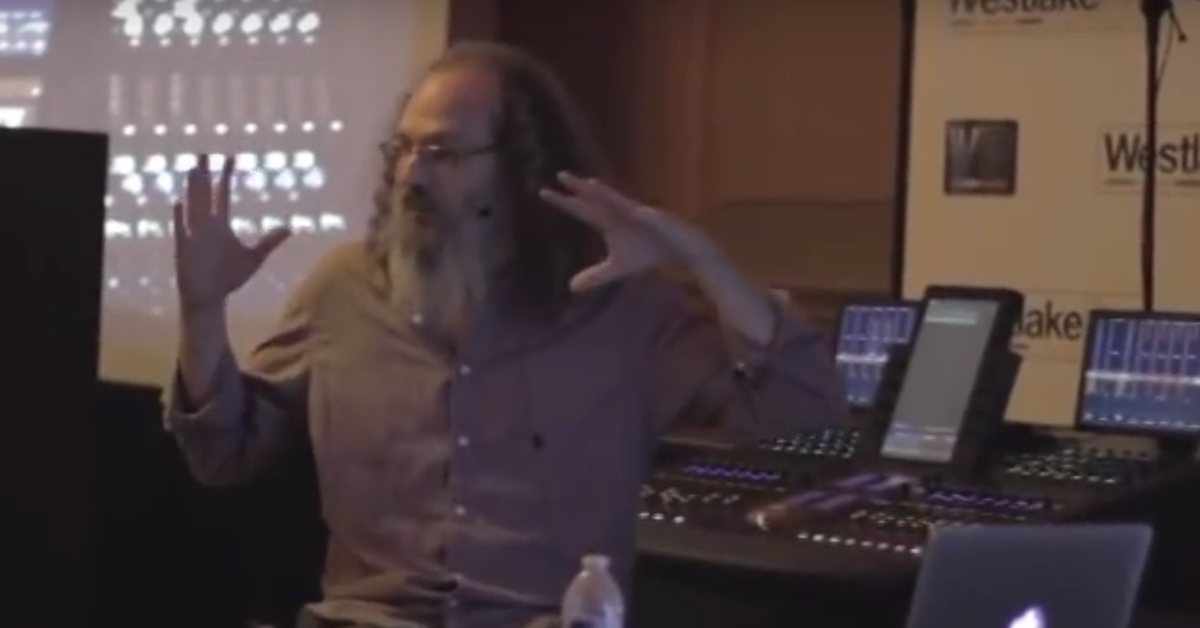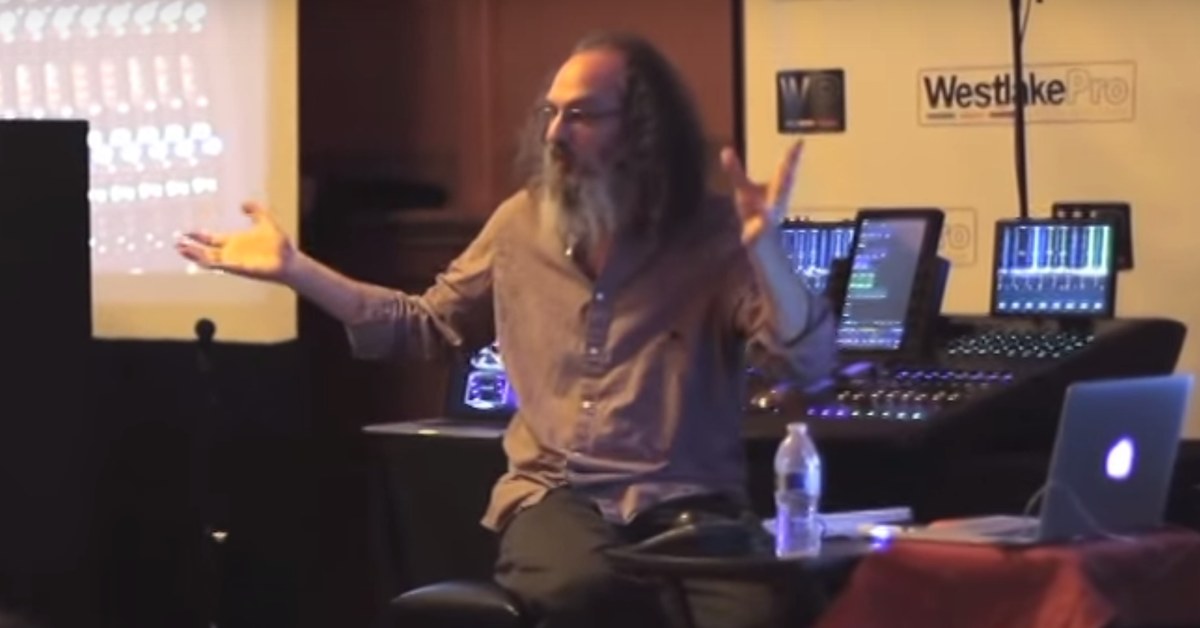Mixing Masterclass with Andrew Scheps — Part 4
[kick drum]
I mean, that’s my kick drum, so the idea being I like to do these thing with parallel processes.
Okay, there are two reasons. So parallel compression. If you don’t know what parallel compression is, has everybody here ever setup a reverb on a send in their mix session? Is there anybody who doesn’t know how to setup a reverb on a send so that multiple things can go to it? Okay, we’re good.
So just get rid of your reverb and put a compressor here instead. That’s it. That’s what parallel compression is. So instead of putting a compressor on something to compress it, you have a send that goes to the compressor. So you’ve got your regular, uncompressed thing, and then you’ve got the return of the compressor next to it. So you have the compressed thing.
There are lots of things that I like about this. One, usually when I put a compressor on something, it changes the sound in a way that I don’t like. There’s something that I miss about the uncompressed sound. Especially drums, the transients change, it’s not cool.
Two, there’s stuff I love about really crushing things like drums, when it brings all of the ambience up and gets super noisy and exciting.
But if you just do that, then you’ve killed all of your transients. So this allows me to blend the two together.
Three, I can send multiple instruments to it. If you try doing this just on a kick drum, and it’s a slow song, and you crush the hell out of it with a parallel compressor, what’ll happen is you hit the kick, and the compressor goes, “pfft!” and then it starts coming up. And it gets super noisy until the next kick comes and slams it down.
This was happening to me on a mix when it actually occurred to me, like, “Hey, the thing that happens in between the kick drums is a snare drum, and if I send a snare drum to that, that’ll keep it down there, and it won’t get super noisy.”
So I did it, and that was my huge epiphany moment about parallel compression.
So there is no — I mean, it could turn out on a particular song that there is a compressor just for a certain instrument. 99% of the time, there is more than one thing going to each of the parallel compressors, except possibly the ones for the vocal, because those are very, very specific, and do really specific things.
So the other thing about parallel compression is think of it this way. If you put a compressor on something, what you’re doing is turning your top levels down to meet your lower level stuff. Right?
So you’re inherently changing the sound of your transient stuff to make it quieter, and then your lower level stuff stays exactly the same.
When you crush the hell out of it and add it in, your transient stuff is still there, but because you’ve got this in-phase, mushed up version of the thing and you add to it, what you’re doing is you’re bringing your low level stuff up to meet the high level stuff, but the high level stuff sounds exactly the same.
If that doesn’t make any sense to you, don’t worry about it. It doesn’t really matter, but conceptually, it’s just a way to think about it, because you start with the uncompressed drums, let’s say, and then you start blending in the parallel compression, and you just put in as much as you want, instead of, “I’m going to compress my drums, okay, wait, they’re too compressed, but I like the way that sounds, so I’m going to back that off, but now I’m going to mess with the release time, because I want to make sure the transients get through, so I want to have a longer attack time, now the compression sounds different, so I have to do more,” and it’s a disaster.
This allows you to just mush the hell out of it, and it also means that the sound of the compressed thing on its own doesn’t really matter a whole lot. It’ll be different depending on how you set the compressor and what compressor you use, but just listening to that compressor on its own doesn’t even mean anything. It’s all about how it adds into the drums.
So now, obviously, having things change their level going into compressors can be kind of a — I was going to use a phrase that’s inappropriate — so yeah, it’s one of those, but generally, these levels are not changing a whole lot once I go, and there’s not a huge amount of this parallel compression mixed in. There’s just enough to really beef things up.
So it used to be, on the Neve console, you had a front buss and a rear buss, because it was built when quad was going to be the next big thing, and it never became the next big thing, but it meant you had this extra stereo buss that was just on buttons right there.
So I would setup kind of my main stereo parallel compression thing on that rear buss, so I could immediately slam any instrument I wanted into this parallel stereo thing, and it would follow exactly the level, the panning, everything that was going on in the front buss, so I wouldn’t have to remember.
In Pro Tools, follow main pan, turn that on as a default on your sends, and you’re golden. Because that way, you pan something, it will re-pan itself into the stereo compressors. Because it’s not like a reverb where left and right are pretty vague. It’s really specific. If it goes to the left side of the compressor, it’s coming out the left side. There’s no mushing over to the other side.
So okay, this compressor — it doesn’t matter what they are, but usually, this is for everything except drums and bass. I don’t know why, but that’s the way this happened.
Usually, it’s some form of 1176-ish thing. On this particular session, it’s this UAD 1176 plug-in, but what you might notice is that I have two of them split on mono tracks, and that’s because UAD doesn’t do multi-mono plug-ins, which really bums me out, because I love stereo compressing things with the compressors unlinked. I don’t like them linked, because especially if I’m sending every instrument in the mix other than bass and drums into this thing, when percussion happens here, I don’t want it turning down the guitar over here. I want it to just interact on its own.
So all I did was group these guys so that the settings are grouped between these two faders, so I could just tweak one while I did it, but you can do it with any compressor.




